2010 CHEVROLET CORVETTE radio
[x] Cancel search: radioPage 385 of 472
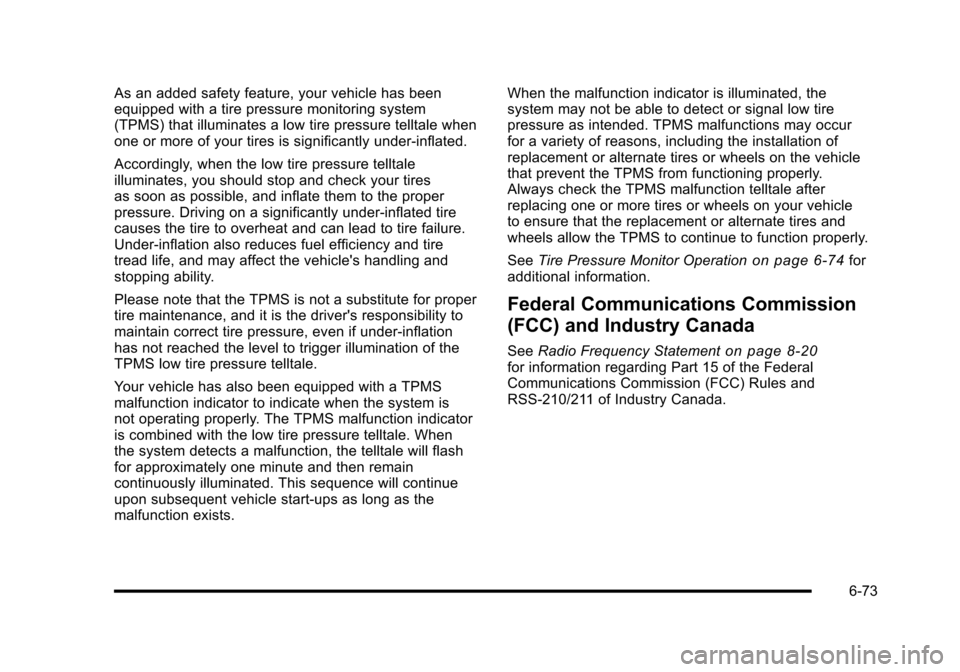
As an added safety feature, your vehicle has been
equipped with a tire pressure monitoring system
(TPMS) that illuminates a low tire pressure telltale when
one or more of your tires is significantly under‐inflated.
Accordingly, when the low tire pressure telltale
illuminates, you should stop and check your tires
as soon as possible, and inflate them to the proper
pressure. Driving on a significantly under‐inflated tire
causes the tire to overheat and can lead to tire failure.
Under‐inflation also reduces fuel efficiency and tire
tread life, and may affect the vehicle's handling and
stopping ability.
Please note that the TPMS is not a substitute for proper
tire maintenance, and it is the driver's responsibility to
maintain correct tire pressure, even if under‐inflation
has not reached the level to trigger illumination of the
TPMS low tire pressure telltale.
Your vehicle has also been equipped with a TPMS
malfunction indicator to indicate when the system is
not operating properly. The TPMS malfunction indicator
is combined with the low tire pressure telltale. When
the system detects a malfunction, the telltale will flash
for approximately one minute and then remain
continuously illuminated. This sequence will continue
upon subsequent vehicle start‐ups as long as the
malfunction exists. When the malfunction indicator is illuminated, the
system may not be able to detect or signal low tire
pressure as intended. TPMS malfunctions may occur
for a variety of reasons, including the installation of
replacement or alternate tires or wheels on the vehicle
that prevent the TPMS from functioning properly.
Always check the TPMS malfunction telltale after
replacing one or more tires or wheels on your vehicle
to ensure that the replacement or alternate tires and
wheels allow the TPMS to continue to function properly.
See
Tire Pressure Monitor Operation
on page 6‑74for
additional information.
Federal Communications Commission
(FCC) and Industry Canada
See Radio Frequency Statementon page 8‑20for information regarding Part 15 of the Federal
Communications Commission (FCC) Rules and
RSS-210/211 of Industry Canada.
6-73
Page 387 of 472
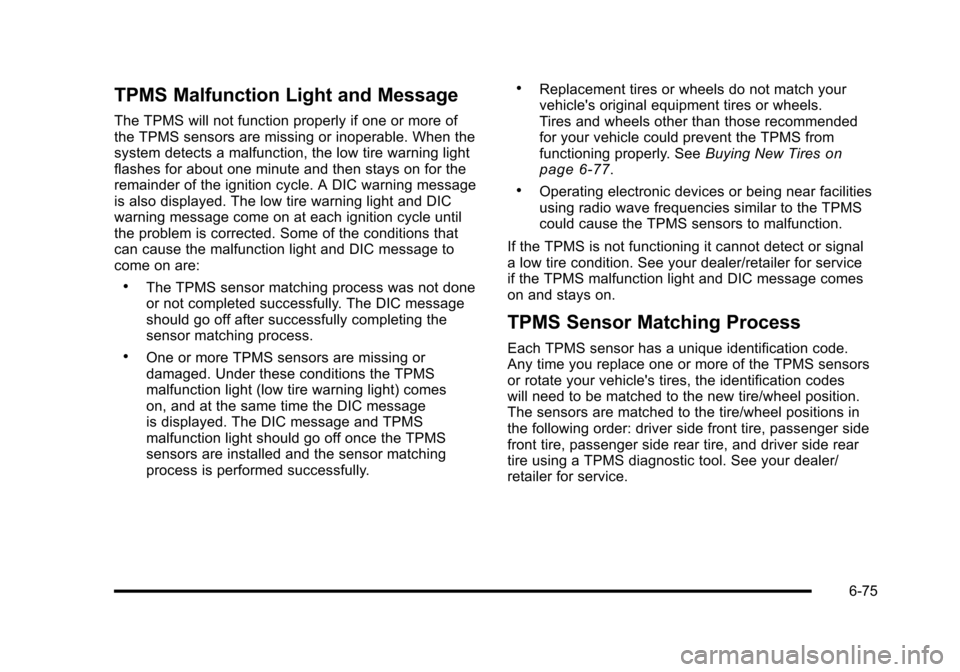
TPMS Malfunction Light and Message
The TPMS will not function properly if one or more of
the TPMS sensors are missing or inoperable. When the
system detects a malfunction, the low tire warning light
flashes for about one minute and then stays on for the
remainder of the ignition cycle. A DIC warning message
is also displayed. The low tire warning light and DIC
warning message come on at each ignition cycle until
the problem is corrected. Some of the conditions that
can cause the malfunction light and DIC message to
come on are:
.The TPMS sensor matching process was not done
or not completed successfully. The DIC message
should go off after successfully completing the
sensor matching process.
.One or more TPMS sensors are missing or
damaged. Under these conditions the TPMS
malfunction light (low tire warning light) comes
on, and at the same time the DIC message
is displayed. The DIC message and TPMS
malfunction light should go off once the TPMS
sensors are installed and the sensor matching
process is performed successfully.
.Replacement tires or wheels do not match your
vehicle's original equipment tires or wheels.
Tires and wheels other than those recommended
for your vehicle could prevent the TPMS from
functioning properly. See Buying New Tires
on
page 6‑77.
.Operating electronic devices or being near facilities
using radio wave frequencies similar to the TPMS
could cause the TPMS sensors to malfunction.
If the TPMS is not functioning it cannot detect or signal
a low tire condition. See your dealer/retailer for service
if the TPMS malfunction light and DIC message comes
on and stays on.
TPMS Sensor Matching Process
Each TPMS sensor has a unique identification code.
Any time you replace one or more of the TPMS sensors
or rotate your vehicle's tires, the identification codes
will need to be matched to the new tire/wheel position.
The sensors are matched to the tire/wheel positions in
the following order: driver side front tire, passenger side
front tire, passenger side rear tire, and driver side rear
tire using a TPMS diagnostic tool. See your dealer/
retailer for service.
6-75
Page 413 of 472
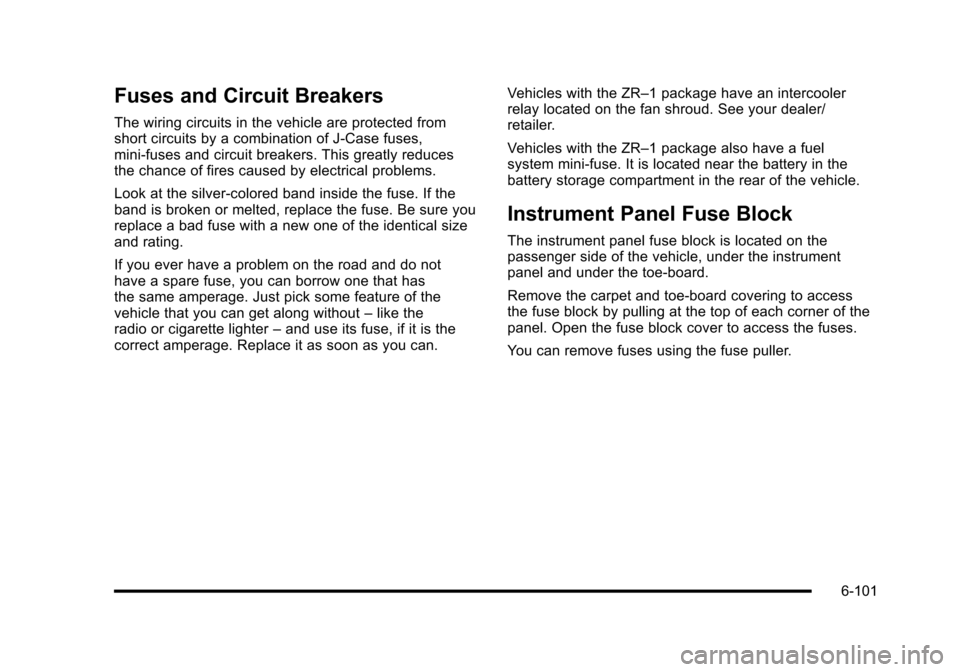
Fuses and Circuit Breakers
The wiring circuits in the vehicle are protected from
short circuits by a combination of J-Case fuses,
mini-fuses and circuit breakers. This greatly reduces
the chance of fires caused by electrical problems.
Look at the silver-colored band inside the fuse. If the
band is broken or melted, replace the fuse. Be sure you
replace a bad fuse with a new one of the identical size
and rating.
If you ever have a problem on the road and do not
have a spare fuse, you can borrow one that has
the same amperage. Just pick some feature of the
vehicle that you can get along without –like the
radio or cigarette lighter –and use its fuse, if it is the
correct amperage. Replace it as soon as you can. Vehicles with the ZR–1 package have an intercooler
relay located on the fan shroud. See your dealer/
retailer.
Vehicles with the ZR–1 package also have a fuel
system mini-fuse. It is located near the battery in the
battery storage compartment in the rear of the vehicle.
Instrument Panel Fuse Block
The instrument panel fuse block is located on the
passenger side of the vehicle, under the instrument
panel and under the toe-board.
Remove the carpet and toe-board covering to access
the fuse block by pulling at the top of each corner of the
panel. Open the fuse block cover to access the fuses.
You can remove fuses using the fuse puller.
6-101
Page 415 of 472
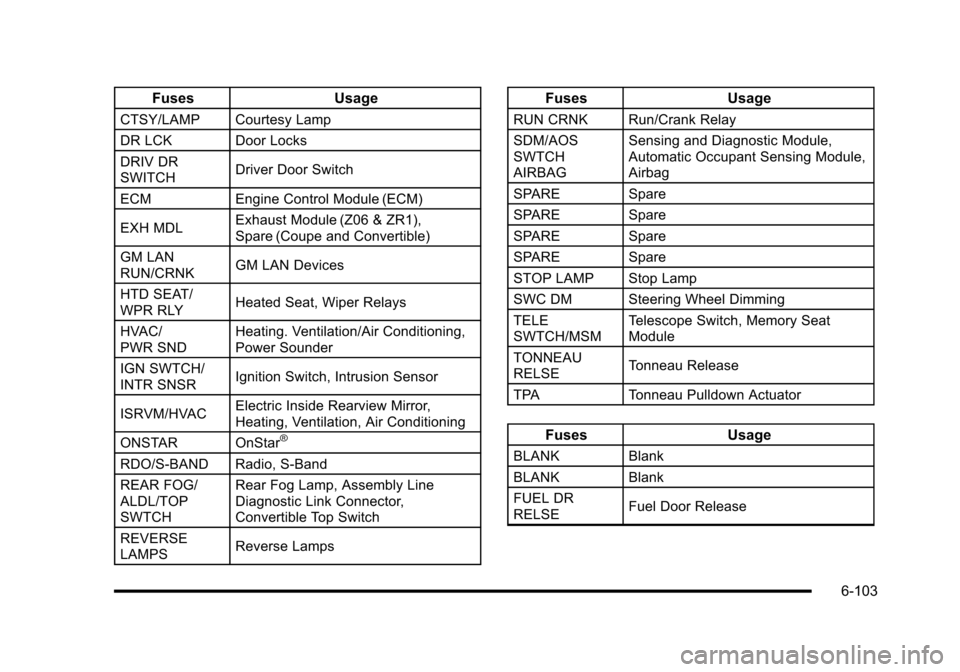
FusesUsage
CTSY/LAMP Courtesy Lamp
DR LCKDoor Locks
DRIV DR
SWITCH Driver Door Switch
ECM Engine Control Module (ECM)
EXH MDL Exhaust Module (Z06 & ZR1),
Spare (Coupe and Convertible)
GM LAN
RUN/CRNK GM LAN Devices
HTD SEAT/
WPR RLY Heated Seat, Wiper Relays
HVAC/
PWR SND Heating. Ventilation/Air Conditioning,
Power Sounder
IGN SWTCH/
INTR SNSR Ignition Switch, Intrusion Sensor
ISRVM/HVAC Electric Inside Rearview Mirror,
Heating, Ventilation, Air Conditioning
ONSTAR OnStar
®
RDO/S‐BAND Radio, S‐Band
REAR FOG/
ALDL/TOP
SWTCH Rear Fog Lamp, Assembly Line
Diagnostic Link Connector,
Convertible Top Switch
REVERSE
LAMPS Reverse Lamps
Fuses
Usage
RUN CRNK Run/Crank Relay
SDM/AOS
SWTCH
AIRBAG Sensing and Diagnostic Module,
Automatic Occupant Sensing Module,
Airbag
SPARE Spare
SPARE Spare
SPARE Spare
SPARE Spare
STOP LAMP Stop Lamp
SWC DM Steering Wheel Dimming
TELE
SWTCH/MSM Telescope Switch, Memory Seat
Module
TONNEAU
RELSE Tonneau Release
TPA Tonneau Pulldown Actuator
Fuses Usage
BLANKBlank
BLANK Blank
FUEL DR
RELSE Fuel Door Release
6-103
Page 439 of 472

Section 8 Customer Assistance Information
Customer Assistance and Information. . . . . . . . . . . 8-2
Customer Satisfaction Procedure . . . . . . . . . . . . . . . 8-2
Online Owner Center . . . . . . . . . . . . . . . . . . . . . . . . . . . . 8-5
Customer Assistance for Text Telephone (TTY) Users . . . . . . . . . . . . . . . . . . . . . . . . . . . . . . . . . . . . . . . . . 8-6
Customer Assistance Offices . . . . . . . . . . . . . . . . . . . 8-6
GM Mobility Reimbursement Program . . . . . . . . . . . 8-7
Roadside Assistance Program . . . . . . . . . . . . . . . . . . 8-7
Scheduling Service Appointments . . . . . . . . . . . . . 8-10
Courtesy Transportation Program . . . . . . . . . . . . . . 8-10
Collision Damage Repair . . . . . . . . . . . . . . . . . . . . . . 8-12 Reporting Safety Defects
. . . . . . . . . . . . . . . . . . . . . . . . 8-15
Reporting Safety Defects to the United States Government . . . . . . . . . . . . . . . . . . . . . . . . . . . . . . . . . 8-15
Reporting Safety Defects to the Canadian Government . . . . . . . . . . . . . . . . . . . . . . . . . . . . . . . . . 8-16
Reporting Safety Defects to General Motors . . . 8-16
Service Publications Ordering Information . . . . . 8-16
Vehicle Data Recording and Privacy . . . . . . . . . . . . . 8-18
Event Data Recorders . . . . . . . . . . . . . . . . . . . . . . . . . 8-18
OnStar
®. . . . . . . . . . . . . . . . . . . . . . . . . . . . . . . . . . . . . . . 8-19
Navigation System . . . . . . . . . . . . . . . . . . . . . . . . . . . . . 8-19
Radio Frequency Identification (RFID) . . . . . . . . . 8-20
Radio Frequency Statement . . . . . . . . . . . . . . . . . . . 8-20
8-1
Page 456 of 472
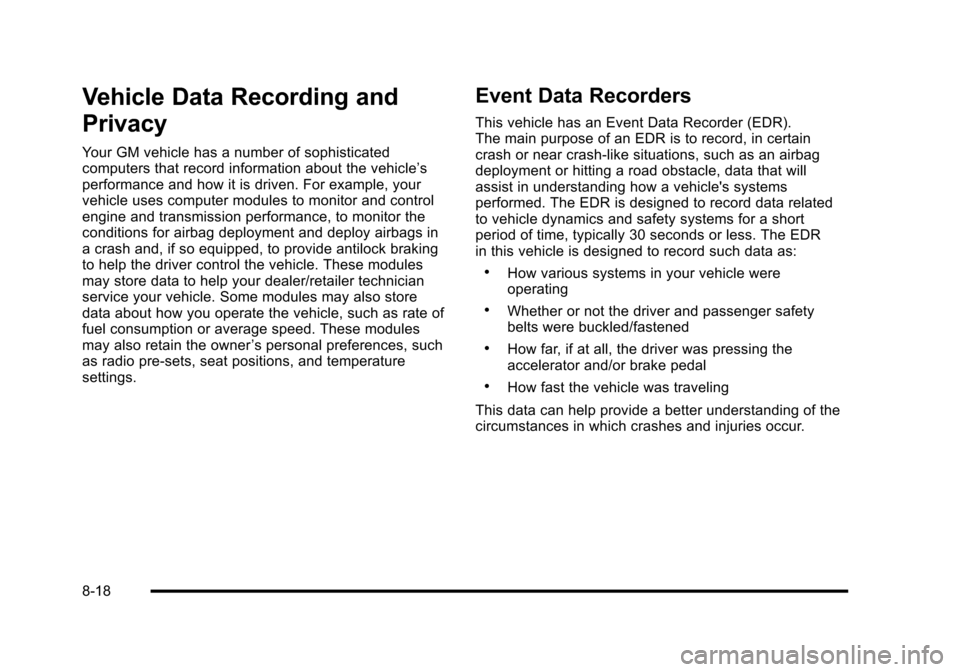
Vehicle Data Recording and
Privacy
Your GM vehicle has a number of sophisticated
computers that record information about the vehicle’s
performance and how it is driven. For example, your
vehicle uses computer modules to monitor and control
engine and transmission performance, to monitor the
conditions for airbag deployment and deploy airbags in
a crash and, if so equipped, to provide antilock braking
to help the driver control the vehicle. These modules
may store data to help your dealer/retailer technician
service your vehicle. Some modules may also store
data about how you operate the vehicle, such as rate of
fuel consumption or average speed. These modules
may also retain the owner ’s personal preferences, such
as radio pre-sets, seat positions, and temperature
settings.
Event Data Recorders
This vehicle has an Event Data Recorder (EDR).
The main purpose of an EDR is to record, in certain
crash or near crash-like situations, such as an airbag
deployment or hitting a road obstacle, data that will
assist in understanding how a vehicle's systems
performed. The EDR is designed to record data related
to vehicle dynamics and safety systems for a short
period of time, typically 30 seconds or less. The EDR
in this vehicle is designed to record such data as:
.How various systems in your vehicle were
operating
.Whether or not the driver and passenger safety
belts were buckled/fastened
.How far, if at all, the driver was pressing the
accelerator and/or brake pedal
.How fast the vehicle was traveling
This data can help provide a better understanding of the
circumstances in which crashes and injuries occur.
8-18
Page 458 of 472
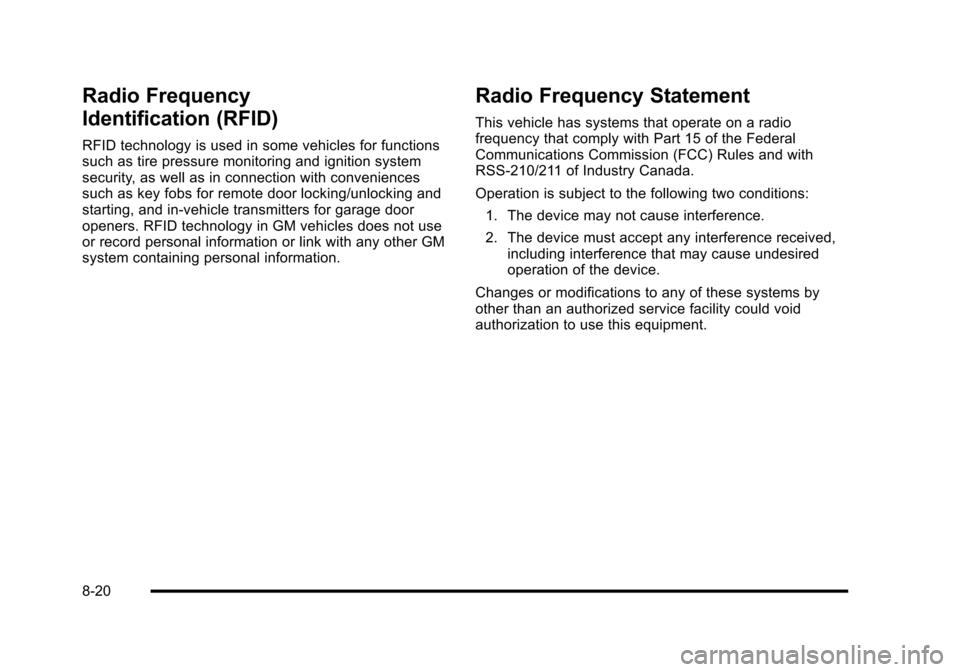
Radio Frequency
Identification (RFID)
RFID technology is used in some vehicles for functions
such as tire pressure monitoring and ignition system
security, as well as in connection with conveniences
such as key fobs for remote door locking/unlocking and
starting, and in-vehicle transmitters for garage door
openers. RFID technology in GM vehicles does not use
or record personal information or link with any other GM
system containing personal information.
Radio Frequency Statement
This vehicle has systems that operate on a radio
frequency that comply with Part 15 of the Federal
Communications Commission (FCC) Rules and with
RSS-210/211 of Industry Canada.
Operation is subject to the following two conditions: 1. The device may not cause interference.
2. The device must accept any interference received, including interference that may cause undesired
operation of the device.
Changes or modifications to any of these systems by
other than an authorized service facility could void
authorization to use this equipment.
8-20
Page 459 of 472

A
Accessories and Modifications . . . . . . . . . . . . . . . . . . . . . . .6-3
Accessory Power . . . . . . . . . . . . . . . . . . . . . . . . . . . . . . . . . . 3-24
Accessory Power Outlets . . . . . . . . . . . . . . . . . . . . . . . . . . 4-20
Active Handling System . . . . . . . . . . . . . . . . . . . . . . . . . . . . .5-8
Active Handling System Light . . . . . . . . . . . . . . . . . . . . . . 4-39
Add-On Electrical Equipment . . . . . . . . . . . . . . . . . . . . . 6-100
Additives, Fuel . . . . . . . . . . . . . . . . . . . . . . . . . . . . . . . . . . . . . . .6-8
Air Cleaner/Filter, Engine . . . . . . . . . . . . . . . . . . . . . . . . . . 6-27
Air Dam, Front . . . . . . . . . . . . . . . . . . . . . . . . . . . . . . . . . . . . . 3-22
Air Filter, Passenger Compartment . . . . . . . . . . . . . . . . 4-28
AirbagAdding Equipment to Your Airbag-EquippedVehicle . . . . . . . . . . . . . . . . . . . . . . . . . . . . . . . . . . . . . . . . . . 2-59
Airbag System How Does an Airbag Restrain? . . . . . . . . . . . . . . . . . . . 2-50
Passenger Sensing System . . . . . . . . . . . . . . . . . . . . . . 2-53
Servicing Your Airbag-Equipped Vehicle . . . . . . . . . . 2-58
What Makes an Airbag Inflate? . . . . . . . . . . . . . . . . . . . 2-50
What Will You See After an Airbag Inflates? . . . . . . 2-51
When Should an Airbag Inflate? . . . . . . . . . . . . . . . . . . 2-48
Where Are the Airbags? . . . . . . . . . . . . . . . . . . . . . . . . . . 2-46
Airbags Passenger Status Indicator . . . . . . . . . . . . . . . . . . . . . . . 4-34
Readiness Light . . . . . . . . . . . . . . . . . . . . . . . . . . . . . . . . . . 4-33
System Check . . . . . . . . . . . . . . . . . . . . . . . . . . . . . . . . . . . . 2-44 Antenna
Diversity . . . . . . . . . . . . . . . . . . . . . . . . . . . . . . . . . . . . . . . . .4-109
Antenna, XM™ Satellite Radio Antenna
System . . . . . . . . . . . . . . . . . . . . . . . . . . . . . . . . . . . . . . . . . . 4-109
Antilock Brake System (ABS) . . . . . . . . . . . . . . . . . . . . . . . .5-5 Warning Light . . . . . . . . . . . . . . . . . . . . . . . . . . . . . . . . . . . . . 4-37
Appearance Care
Aluminum or Chrome-Plated Wheels . . . . . . . . . . . . . 6-97
Care of Safety Belts . . . . . . . . . . . . . . . . . . . . . . . . . . . . . . 6-93
Cargo Cover and Convenience Net . . . . . . . . . . . . . . . 6-93
Chemical Paint Spotting . . . . . . . . . . . . . . . . . . . . . . . . . . 6-99
Cleaning Exterior Lamps/Lenses . . . . . . . . . . . . . . . . . 6-94
Coated Moldings . . . . . . . . . . . . . . . . . . . . . . . . . . . . . . . . . 6-92
Convertible Top . . . . . . . . . . . . . . . . . . . . . . . . . . . . . . . . . . . 6-97
Fabric/Carpet . . . . . . . . . . . . . . . . . . . . . . . . . . . . . . . . . . . . . 6-91
Fiberglass Springs . . . . . . . . . . . . . . . . . . . . . . . . . . . . . . . . 6-99
Finish Care . . . . . . . . . . . . . . . . . . . . . . . . . . . . . . . . . . . . . . . 6-95
Finish Damage . . . . . . . . . . . . . . . . . . . . . . . . . . . . . . . . . . . 6-98
Instrument Panel, Vinyl, and Other PlasticSurfaces . . . . . . . . . . . . . . . . . . . . . . . . . . . . . . . . . . . . . . . . 6-93
Interior Cleaning . . . . . . . . . . . . . . . . . . . . . . . . . . . . . . . . . . 6-90
Leather . . . . . . . . . . . . . . . . . . . . . . . . . . . . . . . . . . . . . . . . . . . 6-92
Removable Roof Panel . . . . . . . . . . . . . . . . . . . . . . . . . . . 6-96
Tires . . . . . . . . . . . . . . . . . . . . . . . . . . . . . . . . . . . . . . . . . . . . . . 6-98
Underbody Maintenance . . . . . . . . . . . . . . . . . . . . . . . . . . 6-98
Washing Your Vehicle . . . . . . . . . . . . . . . . . . . . . . . . . . . . 6-94
Weatherstrips . . . . . . . . . . . . . . . . . . . . . . . . . . . . . . . . . . . . . 6-93
Windshield and Wiper Blades . . . . . . . . . . . . . . . . . . . . . 6-96
i - 1